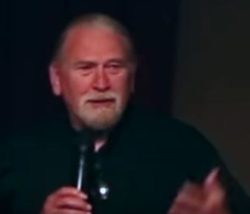
By Timothy Vollmer from Ann Arbor, USA – noe valley looking to mission/bernal heights, CC BY 2.0, https://commons.wikimedia.org/w/index.php?curid=3334964
At PLAN-Boulder County’s annual dinner on September, 23, 2016, San Francisco community organizer Calvin Welch presented a persuasive case that creating more housing units in booming housing markets, such as San Francisco or Boulder, does not lead to lower housing prices. It just leads to more, high-priced housing.

Calvin Welch speaking at the PLAN-Boulder forum
Welch was a founder of the Coalition for San Francisco Neighborhoods and the Council of Community Housing Organizations. He teaches classes at the University of San Francisco and San Francisco State University. He has served on various San Francisco task forces and advisory committees on issues ranging from affordable housing to financing to living wages.
Welch noted that “unaffordable housing” is a phenomenon that has spread across the United States in the last few years and affects almost every city with a thriving economy. He claimed that the free market functions effectively to control prices over the long run for most goods and services, but that it is not able to do so for health care services and housing in highly prosperous urban areas.
Welch marshaled an array of facts and figures to support his position. He asserted that from 1960 to 2000, San Francisco’s population increased by 64,561 people, and it also added a robust 91,933 housing units—or one such unit for every 1.4 new residents. From 2000 to 2009, substantially more market rate dwelling units had been built in San Francisco than the city had set as its goal, while, conversely, “affordable” housing production drastically fell behind the goal. From 2007 to 2016, 77% of the new units produced were “market rate” (that is, affordable by people with incomes above 120% of Area Median Income, or “AMI”), 4% were for “moderate income” residents (120% to 80% of AMI), and 19% were for “lower income” people (less than 80% of AMI). Yet from 1996 to 2015, while the median family income of San Francisco residents increased by 60%, the median price of a single family residence increased by a whopping 398%.
He shared a graph showing that from 1997-2013 the more condominium units that were built in San Francisco, the higher their average price rose, and that, inversely, the fewer such units were built, the lower their average price dropped.
Welch asserted that from 2011 to 2013, 113,000 low or very low income residents moved away from San Francisco. He attributed most of the dramatic increases in housing prices there to an influx of highly paid, “high tech” workers. He, in turn, implied that the spectacular growth of the high tech industry was caused largely by the “quantitative easing” program of the Federal Reserve Bank. Since the 2008-09 “Great Recession,” $4.4 trillion, he said, had been spent on quantitative easing. That money flowed to financial institutions, which, he claimed, had disproportionately invested it in the high tech industry, fueling its ascent.
Although the high tech sector has largely driven the affordable housing crisis in San Francisco and other areas, Welch maintained that it has generally disclaimed any responsibility to ameliorate the problem. Welch also contended that changes in United States government policies have reduced the availability of affordable housing across the country. He noted that the Obama administration’s request for HUD’s budget allocation for 2015 was only 19%, adjusted for inflation, of HUD’s budget for 1978. He also noted that the funding for HUD’s HOME housing assistance program had declined by 55% from 2006-2015 and that from 2007-2013 HUD had reduced the number of people in its renter assistance programs by 159,000. As a result, he claimed, from 2000 to 2014 the population living in neighborhoods with a federally-measured poverty rate of 40% more than doubled.
Welch remarked upon the new-found tendency of the popular media to climb on the ‘let’s-build-more-housing-to-bring-down-prices’ bandwagon. He commented at some length on the behavior of California Governor Jerry Brown, who, in Welch’s opinion, has been prone to promote counter-productive policies as a response to the affordable housing crisis in the Bay Area. Recently, Welch said, Brown had championed state legislation that would have overturned local zoning regulations to allow drastic density bonuses for residential developments in return for paltry affordable housing requirements. Welch said that a coalition of environmentalists, labor unions, affordable housing advocates and other groups managed to defeat this bill.
Welch cautioned that no single approach will reduce the price pressures on low and moderate income people in over-heated housing markets. He extolled the political value of broad-based coalitions and claimed that, at least in California, to be successful, municipal activists concerned about affordable housing have to cultivate alliances at the state level with a diverse set of interest groups.
Dig deeper into Calvin Welch’s talk by watching it below and viewing his slides here.


